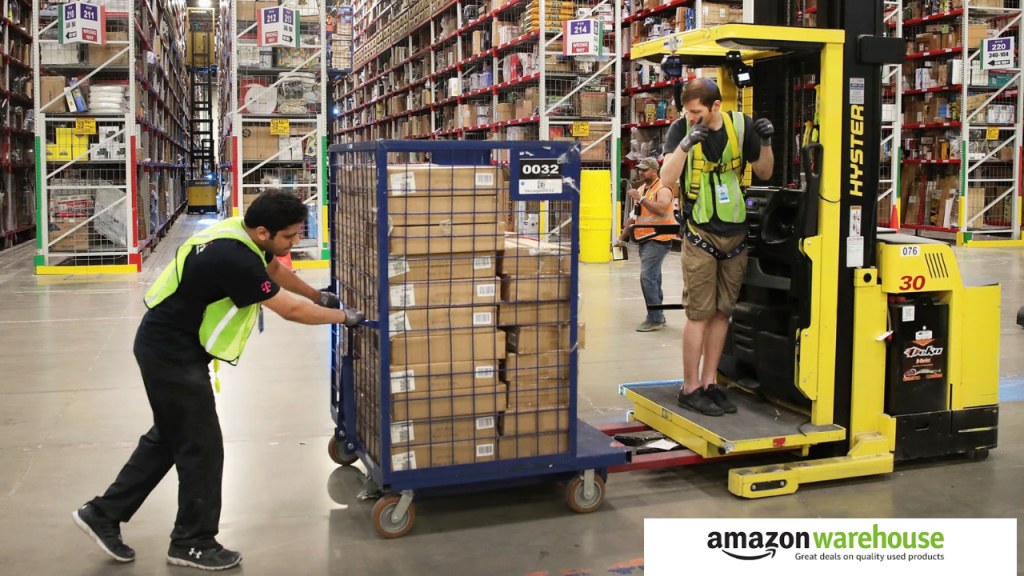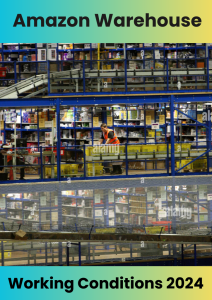
Amazon, a global leader in e-commerce, relies on a highly efficient network of warehouses, known as fulfillment centers, to ensure customers receive their orders quickly and accurately. These warehouses play a crucial role in the company’s supply chain, allowing for rapid processing, packaging, and shipping of millions of products. This comprehensive guide will provide an in-depth understanding of Amazon’s warehouse operations, the types of jobs available, warehouse technologies, safety measures, and what it’s like to work in an Amazon warehouse.

What is an Amazon Warehouse?
An Amazon warehouse, also referred to as a fulfillment center, is a large facility where products are stored, picked, packed, and shipped to customers. These warehouses are strategically located across various regions to optimize delivery times and ensure products are readily available for shipment. Amazon’s warehouses are designed to handle a wide range of items, from small products like electronics and books to large items such as furniture and appliances.
The size of these warehouses varies depending on the location and purpose. Some Amazon fulfillment centers cover more than 1 million square feet and employ thousands of workers. The company’s global network of warehouses enables it to offer fast delivery services like Amazon Prime, which promises one-day or two-day delivery.
Types of Amazon Warehouses
Amazon operates different types of warehouses, each serving a specific purpose in the supply chain. Here are the main types of Amazon warehouses:
- Fulfillment Centers (FCs)These are the primary types of warehouses where customer orders are processed. Fulfillment centers handle picking, packing, and shipping of products. They are equipped with advanced robotics and automation to help workers complete tasks quickly and accurately. Fulfillment centers often operate around the clock to ensure timely order fulfillment.
- Sortation CentersSortation centers are responsible for organizing packages by zip code before they are sent to delivery stations or directly to the post office. These centers help streamline the shipping process by ensuring packages are sorted efficiently for last-mile delivery. Workers at sortation centers focus on organizing packages rather than handling customer orders.
- Delivery StationsDelivery stations are the final stop before packages reach customers. At these stations, packages are loaded onto delivery vehicles and sent out for last-mile delivery. Amazon Flex drivers and third-party delivery partners are often responsible for delivering packages from delivery stations to customers’ doorsteps.
- Prime Now HubsPrime Now hubs cater to Amazon Prime members who want same-day or two-hour delivery. These smaller warehouses store popular items that customers frequently order for rapid delivery. The goal is to meet the growing demand for ultra-fast delivery, especially in urban areas.
- Amazon Fresh WarehousesThese specialized warehouses store groceries and perishable items for Amazon Fresh, the company’s grocery delivery service. They are equipped with refrigeration and freezer sections to keep food items fresh. Orders are picked and packed in temperature-controlled environments to ensure quality.
- Returns CentersReturns centers handle returned items. They process returns, inspect the condition of products, and determine whether items can be resold, refurbished, or recycled. This helps Amazon manage returns efficiently and minimize waste.
The Role of Technology in Amazon Warehouses
Amazon warehouses are known for their use of cutting-edge technology and automation to optimize operations. Here are some of the key technologies used in Amazon’s warehouses:
- Robotics and AutomationAmazon employs robots for various tasks, such as moving shelves (called pods) containing products to human pickers, which speeds up the picking process. The company’s robots, known as Kiva robots, navigate the warehouse floor and help reduce the amount of walking workers need to do, allowing them to focus on picking and packing items.
- Machine Learning and AIArtificial intelligence (AI) and machine learning algorithms are used to predict demand, manage inventory levels, and optimize warehouse layouts. AI helps in forecasting which products will be in high demand, ensuring that inventory is stocked accordingly.
- Warehouse Management Systems (WMS)Amazon’s warehouse management system (WMS) tracks products from the moment they arrive at the warehouse until they are shipped to the customer. It helps manage inventory, optimize picking routes, and ensure that orders are processed in the correct sequence.
- Automated Guided Vehicles (AGVs)AGVs are used to transport items across the warehouse. These vehicles follow predefined routes and can carry heavy loads, reducing the need for manual labor. They help streamline the movement of inventory within the warehouse.
- Barcode Scanners and RFID TechnologyBarcode scanners and Radio-Frequency Identification (RFID) technology are used to track products throughout the warehouse. These tools ensure that inventory is accurately counted and help reduce errors in picking and packing.
- Voice-Picking TechnologyIn some warehouses, voice-picking technology is used to guide workers through the picking process. Workers wear headsets that provide verbal instructions on where to find items, making the picking process faster and reducing the chances of errors.
Jobs Available at Amazon Warehouses
Amazon warehouses offer a variety of job opportunities for individuals with different skill levels. Here are some of the common positions available:
- Warehouse AssociateWarehouse associates are responsible for tasks such as picking, packing, and shipping customer orders. They may also help with inventory management and sorting packages. This role often requires workers to be on their feet for extended periods and perform physical tasks such as lifting heavy boxes.
- Forklift OperatorForklift operators transport large or heavy items within the warehouse using forklifts or other material-handling equipment. They play a crucial role in moving inventory and ensuring that products are in the right place for picking.
- Robotics TechnicianRobotics technicians maintain and repair the robots used in Amazon warehouses. They ensure that the robots operate efficiently and handle any technical issues that arise. This role requires a background in robotics or mechanical engineering.
- Quality Assurance AssociateQuality assurance associates are responsible for inspecting products to ensure they meet Amazon’s quality standards. They may check items for damage, verify packaging, and confirm that the correct products are being shipped to customers.
- Area ManagerArea managers oversee specific sections of the warehouse, ensuring that operations run smoothly. They manage teams of associates, monitor productivity, and implement safety protocols. Area managers need strong leadership skills and experience in logistics or warehouse management.
- Safety SpecialistSafety specialists are responsible for implementing safety procedures and conducting safety training for warehouse employees. They identify potential hazards, conduct safety inspections, and ensure that the warehouse complies with health and safety regulations.
Safety Measures in Amazon Warehouses
Amazon prioritizes the safety of its employees and implements various safety measures to protect workers in its warehouses. Some of the key safety measures include:
- Safety TrainingAll new employees receive safety training during the onboarding process. This training covers topics such as proper lifting techniques, emergency procedures, and the correct use of personal protective equipment (PPE).
- Ergonomic EquipmentAmazon provides ergonomic equipment, such as lifting aids and anti-fatigue mats, to reduce the risk of injury. Workstations are also designed to minimize strain on the body during repetitive tasks.
- Safety Audits and InspectionsRegular safety audits and inspections are conducted to identify potential hazards and ensure compliance with safety standards. Any identified issues are addressed promptly to prevent accidents.
- PPE and Safety GearPersonal protective equipment (PPE), such as gloves, safety glasses, and hard hats, is provided to employees. Workers are required to wear the appropriate safety gear depending on their tasks.
- Automated Safety FeaturesAmazon’s robots and automated systems are equipped with safety features, such as collision detection sensors, to prevent accidents. These systems are designed to stop automatically if they detect an obstacle.
- Wellness ProgramsAmazon offers wellness programs to support the physical and mental health of its employees. These programs include on-site fitness centers, mental health resources, and access to wellness coaches.
What It’s Like to Work in an Amazon Warehouse
Working in an Amazon warehouse can be a physically demanding job that requires workers to perform repetitive tasks for extended periods. However, it also offers a dynamic and fast-paced environment where teamwork is essential. Here’s what you can expect when working in an Amazon warehouse:
- Fast-Paced EnvironmentAmazon warehouses operate with a sense of urgency, especially during peak seasons like Black Friday and the holiday season. Workers are expected to meet productivity targets, which may involve picking or packing a certain number of items per hour.
- Physical DemandsWarehouse jobs can be physically challenging, involving tasks like lifting, bending, and standing for long periods. Workers need to be in good physical condition to perform these tasks safely.
- TeamworkWhile some tasks are performed individually, many aspects of warehouse work require collaboration with other team members. Communication and teamwork are crucial for meeting productivity goals and ensuring safety.
- Opportunities for AdvancementAmazon offers career growth opportunities, and many employees who start in entry-level positions are promoted to higher roles. The company provides training programs to help workers develop new skills and advance their careers.
- Shift WorkAmazon warehouses operate around the clock, meaning employees may work different shifts, including overnight, weekends, and holidays. Shift work provides flexibility for those who prefer non-traditional working hours.
The Impact of Amazon Warehouses on Local Economies
Amazon warehouses contribute significantly to local economies by creating jobs and stimulating economic growth. Here are some of the ways in which Amazon’s warehouse operations impact local communities:
- Job CreationAmazon warehouses provide thousands of jobs in the areas where they are located. These jobs range from entry-level positions to management roles, offering employment opportunities for people with various skills.
- Economic DevelopmentThe presence of an Amazon warehouse often leads to the development of infrastructure, such as roads and transportation networks, to support the facility. This can benefit the local community by improving access to services and other businesses.
- Partnerships with Local BusinessesAmazon collaborates with local businesses for services such as catering, maintenance, and transportation, which helps support small businesses in the area.
- Tax RevenueThe establishment of Amazon warehouses contributes to local tax revenue, which can be used to fund public services such as schools, healthcare, and infrastructure.
Challenges Facing Amazon Warehouses
Despite their success, Amazon warehouses face several challenges, including:
- Worker TurnoverHigh turnover rates are a common issue in Amazon warehouses due to the physically demanding nature of the work. To address this, Amazon invests in employee training and career development programs.
- Safety ConcernsThe fast-paced environment of Amazon warehouses can lead to safety concerns, such as repetitive strain injuries and accidents. Amazon continuously works to improve safety measures to protect employees.
- Environmental ImpactAmazon’s large network of warehouses contributes to its carbon footprint. The company has set ambitious goals to reduce its environmental impact, including achieving net-zero carbon emissions by 2040 and using renewable energy in its facilities.
Future Trends in Amazon Warehouse Operations
Amazon’s warehouse operations are likely to continue evolving with advancements in technology and changes in consumer behavior. Here are some future trends to watch for:
- Increased AutomationAutomation will continue to play a significant role in Amazon warehouses, with more tasks being performed by robots and AI. This could improve efficiency but may also reduce the number of manual labor jobs.
- Sustainability InitiativesAmazon is focusing on sustainability, with efforts to use more renewable energy and reduce packaging waste. Future warehouses may incorporate more green technologies to reduce their environmental impact.
- Expansion of Same-Day DeliveryAs consumer demand for faster delivery increases, Amazon may expand its network of Prime Now hubs and same-day delivery services. This will require more localized fulfillment centers to support rapid delivery.
Conclusion
Amazon warehouses are the backbone of the company’s logistics and supply chain operations, playing a critical role in ensuring customers receive their orders quickly. With a diverse range of warehouse types, cutting-edge technology, and a commitment to safety, Amazon continues to innovate in the field of warehousing and fulfillment. Whether you are considering a job at an Amazon warehouse or are simply interested in learning more about the company’s logistics, understanding the inner workings of these warehouses provides valuable insight into one of the world’s most efficient e-commerce operations.







